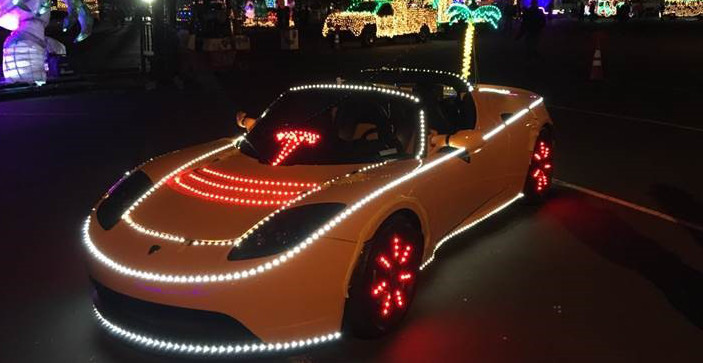What Are the Best Placement Ideas for LED Light Strips in Cars?

In the world of automotive customization, led light strips for cars are transforming how people express their style and enhance their driving experience. From subtle mood lighting to bold, colorful displays, LED strips provide drivers with a way to personalize their vehicles like never before. Thanks to their flexibility, low power consumption, and ease of installation, they can be placed almost anywhere—inside or outside a car—to create ambiance, boost visibility, and elevate aesthetics.
Whether you’re aiming for a futuristic vibe, a luxurious interior glow, or simply want your vehicle to stand out in a parking lot, LED lighting placement makes all the difference. Where you install these lights not only affects how they look but also how practical and road-safe they are.
It’s similar to the balance sought by led light strips for cars —they want functionality, reliability, and style all in one. The right LED setup must be stylish without being distracting, efficient without being overpowering, and most importantly, legal and safe. This article explores the most effective and visually pleasing placement ideas for LED strips inside and outside your vehicle, ensuring your lighting upgrade adds value rather than clutter.
Why Placement Matters in Automotive LED Lighting
You could buy the brightest, most dynamic LED strip available, but if it’s installed poorly or placed in a spot that doesn’t highlight the car’s design, the effort will fall flat. Lighting placement influences how the cabin feels at night, how the car is perceived from the outside, and even how safe your drive is.
Interior lighting, for example, should provide atmosphere without being a distraction. Exterior lighting might highlight curves, grilles, or undercarriages, but it must follow local laws to avoid fines. So, strategic placement isn’t just about aesthetics—it’s about optimizing both experience and compliance.
Ambient Lighting Beneath the Dashboard
One of the most popular and elegant ways to use LED light strips is beneath the dashboard, near the footwell area. This creates a soft glow that’s visible when driving at night but doesn’t interfere with vision or attention. Colors can be matched to your car’s interior, providing a unified, luxurious appearance.
Drivers often opt for dimmable strips here to control brightness based on mood or time of day. Many aftermarket kits also include sound-reactive or motion features that sync lighting with music or vehicle movement, enhancing the immersive effect.
Door Panel Illumination
Integrating LED light strips into door panels adds a futuristic feel, especially when lights activate as doors open or close. Some installations even incorporate motion sensors, illuminating the entry area as passengers approach the vehicle.
This placement not only boosts style but also enhances safety, making it easier to locate door handles and compartments in the dark. Door panel lighting is often paired with ambient dashboard lighting to create a full cabin lighting experience, blending function with flair.
Under-Seat LED Strip Installation
Another subtle yet effective placement for LED strips is beneath the front or rear seats. This creates a soft underglow across the vehicle floor, which adds dimension and depth to the cabin lighting. Unlike overhead lights, under-seat lighting does not strain the eyes or cause reflections on windows.
This style is particularly useful in ride-sharing or chauffeuring environments, where soft, non-intrusive lighting contributes to a premium experience for passengers. When combined with remote control or smartphone app integration, under-seat lights can be easily toggled or dimmed for perfect nighttime ambiance.
Center Console Accents
The center console, which houses gear shifters, cup holders, and controls, offers a prime location for LED lighting. A thin strip around the border of the console can make the area feel more modern and upscale. Illuminated cup holders, if your kit includes them, are both practical and visually appealing, especially on night drives.
This setup also mirrors the approach used in luxury vehicles, where illuminated interiors define the overall brand aesthetic. It’s one of the best ways to upgrade the look of your car without significant modifications.
Trunk and Boot Area Lighting
Adding LED light strips in your trunk or boot area isn’t just a design statement—it’s extremely practical. Factory trunk lights are often dim and uneven. LED strips provide even lighting throughout the space, making it easier to load and unload at night.
Installation here is typically straightforward, and many choose motion-activated lights that only turn on when the trunk is open. It’s a small change that adds significant convenience and visual appeal.
Door Sill and Threshold Lighting
Installing LED strips along the door sills or thresholds adds a professional finish to any car upgrade. Many high-end models now include illuminated sills with brand logos or customized messages. These are activated when doors open and can create a strong first impression.
You can find universal kits or customized versions for specific vehicle makes. Besides looking cool, illuminated sills also help prevent tripping or stumbling in low-light situations when entering or exiting the car.
Roof Liner and Starlight Effects
The starlight roof effect has become iconic, thanks to luxury brands like Rolls-Royce. This look can now be replicated with LED fiber optics installed into the roof liner. While more complex than basic strip lighting, the results are stunning.
Installing light strips along the edges of the roof liner or near sunroofs can also produce a soft halo effect, giving the impression of a larger and more open cabin. This is a dramatic yet tasteful upgrade when done correctly.
Engine Bay and Hood Area Lighting
For automotive show enthusiasts or those with a love for performance visuals, placing LED light strips in the engine bay is a bold choice. When combined with a transparent or open hood, this adds a futuristic glow to your engine components.
While this is more for display purposes than practical use, it’s a conversation starter at car meets and exhibitions. Just ensure all wiring is heat-resistant and securely installed to handle the engine’s temperatures.
Underbody and Underglow Lighting
The underbody remains one of the most popular exterior locations for LED lighting. Underbody lights give the illusion of a floating car and create visual drama during night drives. Though striking, underglow lighting must be installed and used responsibly, especially in countries like Australia, where road laws strictly regulate exterior lighting.
In most jurisdictions, the lights should not flash, change colors while driving, or mimic emergency colors like red or blue. When installed properly and legally, underglow can be a game-changing upgrade for car aesthetics.
Grille and Front Fascia Accents
Adding LED strips to the grille area or around the front fascia enhances the face of your vehicle. Many custom lighting kits now include DRL-style (daytime running light) LED strips that sync with headlights or blinkers.
The front of the vehicle is always the first thing people see, and properly installed lighting here can change the vehicle’s presence on the road. As always, avoid red or blue lighting in front-facing positions unless the strips are strictly for show purposes on private property.
Headliner Accent Lighting
A lesser-known yet impactful LED placement is along the edge of the headliner or roof trim. This adds a continuous, soft glow that subtly defines the cabin shape. It also improves visibility inside the vehicle at night without relying on harsh dome lights.
This lighting trick is especially popular in sedans and coupes, where the ceiling contours are prominent. When synced with music or controlled via remote, it offers a surprisingly high-end touch for very little effort.
Safety, Legality, and Electrical Planning
It’s easy to get carried away with creative ideas when designing your LED layout. However, before finalizing your setup, remember that placement affects not just style—but also safety and legality. Always consult your country or state’s vehicle lighting laws. In Australia, for example, flashing or multicolored exterior lights can lead to fines or vehicle inspection requests.
Plan your wiring carefully. Use appropriate fuses, avoid tapping into sensitive vehicle circuits, and make sure all connections are secure and weatherproof—especially for exterior lighting. Poor installation not only risks draining your battery but could create electrical hazards.
Syncing With Car Tech: Smart Integration
Modern lighting kits now come with app-based control, voice commands, and even automation features. You can program lighting scenes, music-reactive displays, or motion-sensitive lights using your smartphone. Just as smart watch women rely on app sync to monitor and adjust their tech seamlessly, drivers can use the same approach to personalize their lighting experience.
These features make it easier to control brightness, color, timing, and transitions. Whether you want a show-ready setup or a relaxing nighttime interior, smart lighting integration offers both convenience and style.
Longevity and Maintenance
Once your lights are installed, maintenance is fairly minimal—but still important. Periodically check your strips for wear, fading, or adhesive peeling. Replace faulty segments and clean the LED surfaces to keep brightness levels optimal. Weather can affect exterior strips over time, so waterproofing and protective casing go a long way in preserving your setup.
Battery health is also worth monitoring, especially if you have multiple strips running. Use switches or ignition-based power sources to ensure your lighting doesn’t draw current when the engine is off.
Final Thoughts: Placement Is the Secret to Great Automotive Lighting
So, what are the best placement ideas for LED light strips in cars? The answer lies in a thoughtful mix of aesthetics, safety, and functionality. Whether you’re illuminating footwells, adding ambient glow to door panels, or going bold with underglow lighting, each location brings a different energy to your vehicle.
Strategic placement elevates your car’s style without becoming overwhelming or distracting. With quality materials, careful wiring, and smart controls, your lighting setup can feel as premium and personalized as those found in high-end luxury vehicles.




